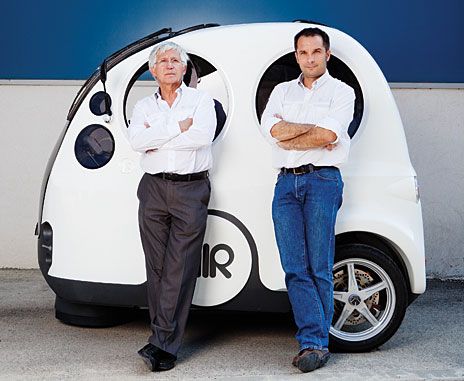Search This Blog
Blog Archive
Followers
Green cars could run on compressed air instead of batteries. But don't rely on the new AirPod minicars to prove it
A new celebrity with a lusciously curved body is turning heads on France’s Côte d’Azur. No, not that kind of body. This one belongs to the AirPod, a 220-kilogram car with a sculpted composite shell and a back-to-the-future energy supply: 80 kg of air compressed to 350 times sea-level atmospheric pressure, roughly 350 bars. The engine of this tiny three-seater converts that air into mechanical energy, just as a pneumatic jackhammer does to blast apart concrete.
The AirPod won’t exactly tear up the road, though: The current version tops out at 45 kilometers per hour (28 miles per hour). And yet there’s definitely something addictive in its joystick steering and featherlike suspension. With expanding air pumping its pistons, the exhaust is literally a superchilled breeze. Grab the stick, step on the accelerator, and any guilt you may be harboring from driving an ordinary smog-producing carbon spewer falls away. Wouldn’t life be great if everybody got around town in these clean little machines?
This rosy vision of future urban transport is the product of Motor Development International (MDI), a company registered in Luxembourg whose tech-chic atelier lies in Carros, a palmy industrial suburb of Nice, France. Guy and Cyril Nègre [above], the father-and-son team behind MDI, predict their technology will find mass appeal in the emerging city-car category, an automotive segment of small, efficient cars well suited for crowded European and Asian cities and not meant for long-haul trips.
Most carmakers think that battery power is the future for this category, but the Nègres beg to differ. The AirPod, they promise, can tank up in just 2 or 3 minutes using no more than 1.5 euros’ worth of France’s nuclear-heavy, low-CO2 electricity to provide some 220 km (137 miles) of city driving. It has no batteries to wear out and replace—and so will cause no worries about its power source ever erupting in flames. And the AirPod will cost a mere €6000, the Nègres say (less than US $9000).
Storing energy in a long-lasting pressure tank made of carbon fiber rather than in batteries, posit the Nègres, makes the AirPod cheaper, more practical, and cleaner than a comparable electric vehicle (EV), once you take manufacturing and disposal into account. It’s a bold assertion, and one that remains to be proved, which won’t be possible until these cute little cars actually hit the road. And when that will happen is anyone’s guess.
Though the AirPod is supposed to go on sale in a couple of months, the Nègres have been struggling to commercialize pneumatic vehicles for more than a decade, incurring a reputation for unfulfilled promises. No independent testing laboratory has assessed the AirPod’s performance. And while deals over the past three years with India’s Tata Motors and Paris-based Air France have bolstered MDI’s credibility, it remains tough to find an automotive engineer who buys into the company’s vision. The fundamental problem, they say, is the laws of thermodynamics, which make compressed air an impractical power source for vehicles. The AirPod’s 200-liter tank is roughly the size of a common 55-gallon drum, but it carries the energy of little more than a liter of gasoline. And its air-powered engine makes inefficient use of it. MDI counters that the ultralight, low-speed AirPod needs very little to get around. Yet skeptics abound.
“I don’t know how they can deliver what they claim,” says Denis Clodic, a mechanical engineer and thermodynamics expert at France’s prestigious École des Mines de Paris. “It’s not a solution for the sort of vehicle we expect today,” says Pascal Higelin, professor and director of the Mechanics and Energy Laboratory at the University of Orléans, in France.
And yet Higelin and Clodic count themselves among the growing number of propulsion authorities who say that vehicles combining compressed air and fuel combustion could overcome the primary drawbacks of both, providing an economical alternative to today’s gasoline-electric hybrids. The greatest impediment to realizing such pneumatic hybrids, according to these two experts, is that the failure of MDI’s air car could cast doubt on the whole idea.
Subscribe to:
Post Comments (Atom)

0 comments:
Post a Comment